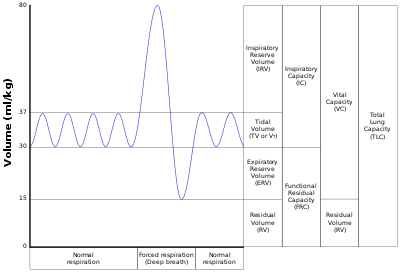Vital capacity
Vital capacity (VC) is the maximum amount of air a person can expel from the lungs after a maximum inhalation. It is equal to the sum of inspiratory reserve volume, tidal volume, and expiratory reserve volume. It is approximately equal to Forced Vital Capacity (FVC).[1][2]

A person's vital capacity can be measured by a wet or regular spirometer. In combination with other physiological measurements, the vital capacity can help make a diagnosis of underlying lung disease. Furthermore, the vital capacity is used to determine the severity of respiratory muscle involvement in neuromuscular disease, and can guide treatment decisions in Guillain–Barré syndrome and myasthenic crisis.
A normal adult has a vital capacity between 3 and 5 litres.[3] A human's vital capacity depends on age, sex, height, mass, and possibly ethnicity.[4] However, the dependence on ethnicity is poorly understood or defined, as it was first established by studying black slaves in the 19th century[5] and may be the result of conflation with environmental factors.[6]
Lung volumes and lung capacities refer to the volume of air associated with different phases of the respiratory cycle. Lung volumes are directly measured, whereas lung capacities are inferred from volumes.
Role in Diagnosis
The vital capacity can be used to help differentiate causes of lung disease. In restrictive lung disease the vital capacity is decreased. In obstructive lung disease it is usually normal or only slightly decreased.[7]
Estimated vital capacities
| Height | 150–155 cm (5'–5'2") | 155–160 cm (5'2"–5'4") | 160–165 cm (5'4"–5'6") | 165–170 cm (5'6"–5'8") | 170–175 cm (5'8"–5'10") | 175–180 cm (5'10"–6') |
|---|---|---|---|---|---|---|
| Vital capacity (cm3) | 2900 | 3150 | 3400 | 3720 | 3950 | 4300 |
| Age | 15–25 | 25–35 | 35–45 | 45–55 | 55–65 |
|---|---|---|---|---|---|
| Vital capacity (cm3) | 3425 | 3500 | 3225 | 3050 | 2850 |
Formulas
Vital capacity increases with height and decreases with age. Formulas to estimate vital capacity are:[3]
where is approximate vital capacity in cm3, is age in years, and is height in cm.
Several studies have been made to measure and predict vital capacity.[9][10][11][12][13]
References
- Chhabra, S. K. (1998). "Forced Vital Capacity, Slow Vital Capacity, or Inspiratory Vital Capacity: Which is the Best Measure of Vital Capacity?". Journal of Asthma. 35 (4): 361–365. doi:10.3109/02770909809075669. PMID 9669830.
- https://www.uofmhealth.org/health-library/aa73564
- "Vital Capacity". Family Practice Notebook. Retrieved 19 February 2015.
- Hutchinson, J (1846). "On the capacity of the lungs, and on the respiratory functions, with a view of establishing a precise and easy method of detecting disease by the spirometer". Med Chir Trans. 29: 137–252. doi:10.1177/095952874602900113. PMC 2116876. PMID 20895846.
- Villarosa, Linda (2019-08-14). "How False Beliefs in Physical Racial Difference Still Live in Medicine Today". The New York Times. ISSN 0362-4331. Retrieved 2019-08-15.
- Braun, Lundy (2015). "Race, ethnicity and lung function: A brief history". Canadian Journal of Respiratory Therapy. 51 (4): 99–101. ISSN 1205-9838. PMC 4631137. PMID 26566381.
- "Pulmonary Function Tests". UCSD. Retrieved 19 February 2015.
- Pratt, Joseph H. (1922). "Long-continued observations on the vital capacity in health and in heart disease". Transactions of the Association of American Physicians. W. J. Dornan, Incorporated. 37: 182–197.
- E. Berglund, G. Birath, J. Bjure, G. Grimby, I. Kjellmer, L. Sandqvist, B. Söderholm. Spirometric Studies in Normal Subjects. Acta Medica Scandinavica, Vol. 173, fasc. 2, pp. 185-206, 1963.
- G. Forche, K. Harnoncourt, E. Stadlober. Neue spirometrische Bezugswerte für Kinder, Jugendliche und Erwachsene. Öst. Ärzteztg. 43/15/16, p.40, 1988.
- A. Gulsvik. Spirometri (Korrespondanse). Tidsskr Nor Loegeforen nr. 31, 105, pp.2240-2, 1985.
- H. Hedenström, P. Malmberg, K. Agarwal. Reference Values for Lung Function tests in Females. Bull. Eur. Physiopathol. Respir. 21, pp. 551-557, 1985.
- A. Langhammer, R. Johnsen, A. Gulsvik, T.L. Holmen, L. Bjermer, Forced spirometry reference values for Norwegian adults: the Bronchial Obstruction in North Trøndelag study. Eur. Respir. J. Volume 18, pp. 1-10. 2001.